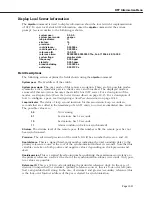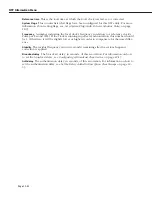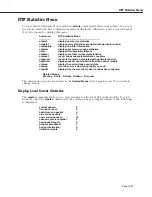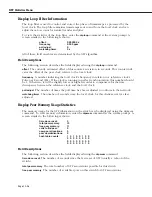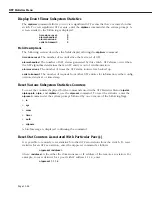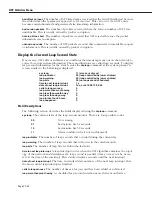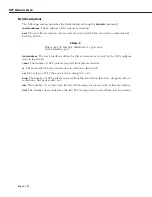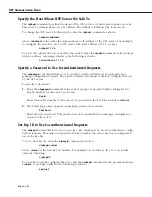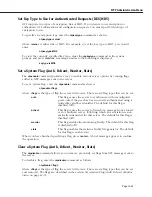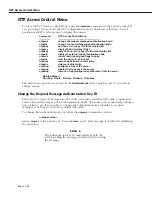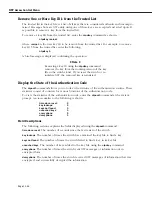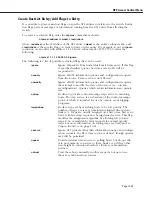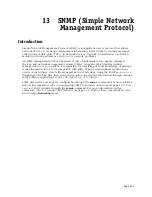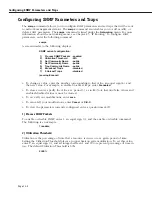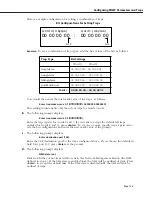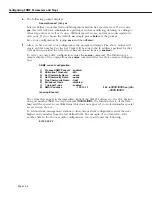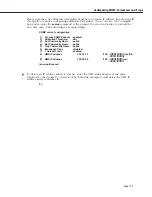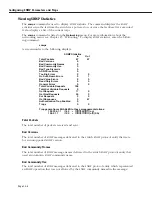
NTP Administration Menu
Page 12-35
Set Key Type to Use for Authenticated Requests (DES|MD5)
NTP
supports two types of encryption:
DES
or MD5. If you decide to use encryption to
authenticate
NTP
information and configuration requests, you must specify which type of
encryption to use.
To specify an encryption type enter the
ntpkeytype
command as shown:
ntpkeytype <value>
where
<value>
is either
DES
or MD5. For example, to set the key type to MD5, you would
enter:
ntpkeytype MD5
To view the currently specified key type, enter the
ntpkeytype
command at the system
prompt, and press
<return>
. A message similar to the following is displayed:
keytype is MD5
Set a System Flag (Auth, Bclient, Monitor, Stats)
The
ntpenable
command provides a way to enable various server options by creating flags
added to NTP messages sent to the server.
To set a system flag, enter the
ntpenable
command as shown:
ntpenable <flag>
where
<flag>
is the type of flag the server will receive. There are six flag types that can be set:
auth
This flag causes the server to synchronize with unconfigured
peers only if the peer has been correctly authenticated using a
trusted key and key identifier. The default for this flag is
disabled (off).
bclient
This flag causes the server to listen for a message from a broad-
cast or multicast server, following which an association is auto-
matically instantiated for that server. The default for this flag is
disabled (off).
monitor
This flag enables the monitoring facility. The default for this flag
is disabled (off).
stats
This flag enables the statistics facility file generator. The default
for this flag is enable (on).
When you have finished specifying a flag, press
<enter>.
A brief message appears to confirm
the operation.
Clear a System Flag (Auth, Bclient, Monitor, Stats)
The
ntpdisable
command allows you to remove previously set flags from
NTP
messages sent to
the server.
To disable a flag, enter the
ntpdisable
command as follows:
ntpdisable <flag>
where
<flag>
is the type of flag the server will receive. There are six flag types that can be set
and removed. The flags are described in the section
Set a System Flag (Auth, Bclient, Monitor,
Stats)
on page 12-35.
Summary of Contents for Omni Switch/Router
Page 1: ...Part No 060166 10 Rev C March 2005 Omni Switch Router User Manual Release 4 5 www alcatel com ...
Page 4: ...page iv ...
Page 110: ...WAN Modules Page 3 40 ...
Page 156: ...UI Table Filtering Using Search and Filter Commands Page 4 46 ...
Page 164: ...Using ZMODEM Page 5 8 ...
Page 186: ...Displaying and Setting the Swap State Page 6 22 ...
Page 202: ...Creating a New File System Page 7 16 ...
Page 270: ...Displaying Secure Access Entries in the MPM Log Page 10 14 ...
Page 430: ...OmniChannel Page 15 16 ...
Page 496: ...Configuring Source Route to Transparent Bridging Page 17 48 ...
Page 542: ...Dissimilar LAN Switching Capabilities Page 18 46 ...
Page 646: ...Application Example DHCP Policies Page 20 30 ...
Page 660: ...GMAP Page 21 14 ...
Page 710: ...Viewing the Virtual Interface of Multicast VLANs Page 23 16 ...
Page 722: ...Application Example 5 Page 24 12 ...
Page 788: ...Viewing UDP Relay Statistics Page 26 24 ...
Page 872: ...The WAN Port Software Menu Page 28 46 ...
Page 960: ...Deleting a PPP Entity Page 30 22 ...
Page 978: ...Displaying Link Status Page 31 18 ...
Page 988: ...Displaying ISDN Configuration Entry Status Page 32 10 ...
Page 1024: ...Backup Services Commands Page 34 14 ...
Page 1062: ...Diagnostic Test Cable Schematics Page 36 24 ...
Page 1072: ...Configuring a Switch with an MPX Page A 10 ...
Page 1086: ...Page B 14 ...
Page 1100: ...Page I 14 Index ...

